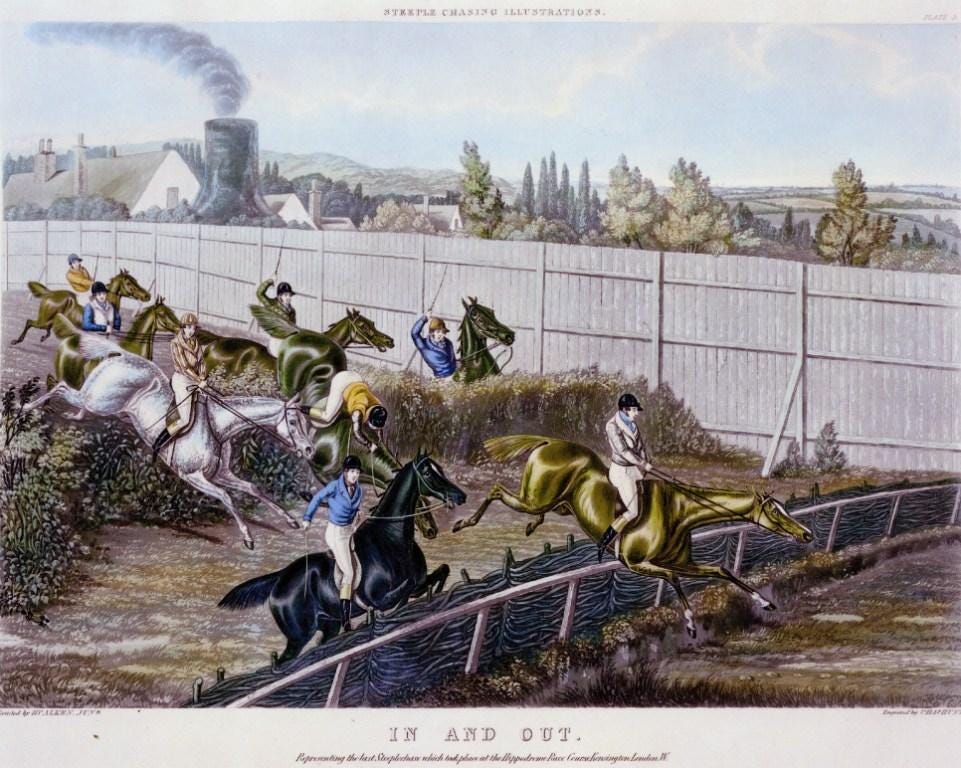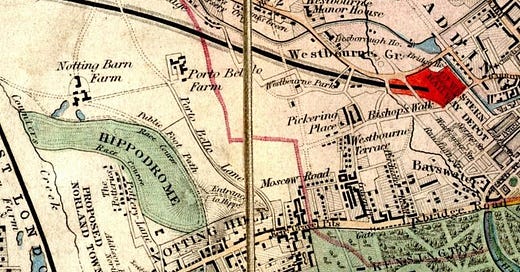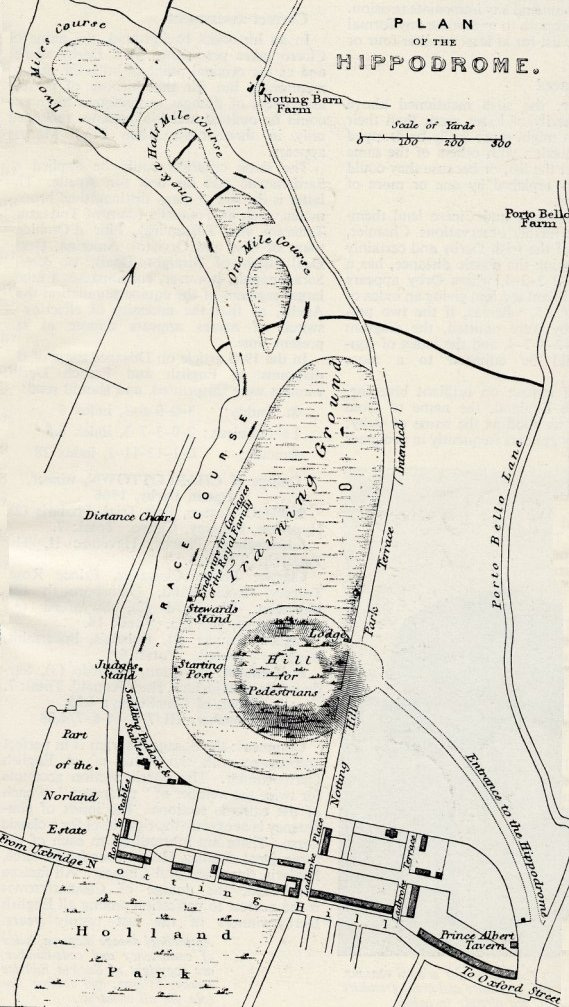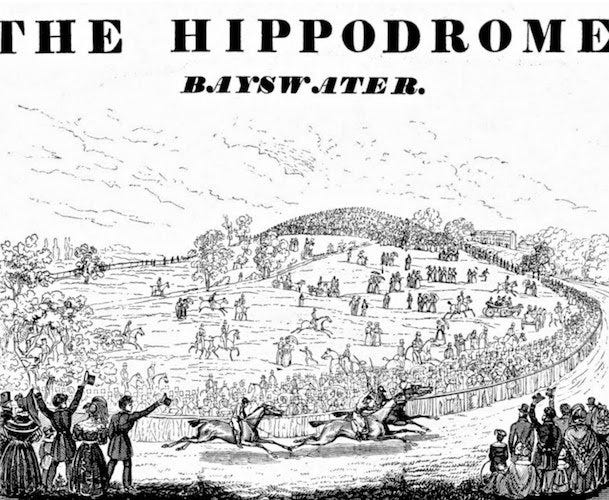The Kensington Hippodrome
The rich streets at the summit of London's Notting Hill hide a former racecourse
In 1837, Queen Victoria came to the throne. The same year saw the inauguration of a new venture to the west of London - an attempt to establish a racecourse which would rival Epsom and Ascot in its attractions.
The prospectus, issued in 1836, stated that
An extensive range of land, in a secluded situation, has been taken and thrown into one great Park, and is being fenced in all round by a strong, close, high paling. This Park affords the facilities of a STEEPLE-CHASE COURSE, intersected by banks and every description of fence; and also of a RACE-COURSE distinct from the Steeple-Chase Course; and each Course is capable of being suited to a Four Mile Race for Horses of the first class.
The initiator of this endeavour was Mr John Whyte of Brace Cottage in Notting Hill, who leased around 200 acres from James Weller Ladbroke, the ground landlord. The original course was bounded by Portobello Road, Elgin Crescent, Clarendon Road and the south side of Ladbroke Square. The primary entrance was through an arch at the junction of Kensington Park Road with Pembridge Road, just beside the Prince Albert pub which was already in existence.
NOTE: The above map is taken from Whyte’s 1836 prospectus. If you know the area and want some bearings, the Prince Albert pub (shown bottom right) is at the junction of Pembridge Road and Kensington Park Road. Modern Holland Park Avenue is the road marked as ‘Notting Hill’. The entrance pathway would cross modern Ladbroke Square emerging onto the ‘Hill for Pedestrians’. This circle around that hill still marks Stanley Crescent and Lansdowne Crescent. West of there, the ‘Judges Stand’ and stables would be at Hippodrome Mews. Such was the extent of the racecourse that Notting Barns Farm at the top of the map was located as far north as the modern junction of St Marks’ Road with Oxford Gardens. The westernmost extent of the course nearly stretched to Wood Lane.
The intention of the racecourse was to provide facilities for various equestrian exercises and outdoor sports on non-racing days.
The venture took various names: The Kensington Hippodrome, The Notting Hill Racecourse, The Bayswater Hippodrome and even - briefly - Victoria Park, in honour of the new Queen.
The inaugural meeting took place on 3 June 1837, featuring three races with a total prize list of £250. A second meeting followed on the 19th. While the company was considered splendid and attracted many "splendid equipages," the quality of the racing received mixed reviews. One commentator referred to the horses entered as "animated dogs' meat."
Mr Whyte's zeal to enclose the course led to a dispute over a right-of-way. There was a long-established footpath linking Holland Park Avenue over the fields to Notting Barns Farm.
Local residents took matters into their own hands by cutting down the paling at the footpath's entrance. This led to increased crowds, including unruly individuals taking advantage of the dispute to enter without paying for admission.
Over the following two years, all efforts by Mr Whyte to close the footpath faced frustration. The situation escalated into summonses, counter summons, assaults, petitions to Parliament by local inhabitants and parochial authorities, along with a contentious and scurrilous exchange in the columns of the press. There was even a proposal, at one point, to construct a subway under the racecourse. However, in 1839, Mr. Whyte conceded the unequal struggle and relinquished the eastern half of the ground.
The course was next expanded northward to the vicinity of the present St Helen's Church on St Quintin's Avenue. As the prospectus highlighted:
The race-course [was] lengthened and much improved, and without interfering with the rights of the public, the footpath, which intersected the old ground, will now run at the outside of the Park.
A management committee, consisting of noblemen and gentlemen, was established, and £50,000 in capital was raised through the sale of £10 shares, with the holder of two shares entitled to a transferable ticket of admission.
Even though the footpath issue had been settled, a more significant obstacle to the success of the venture soon became apparent. The clay soil led to heavy going and required extensive drainage, rendering the course unusable at certain times of the year, and this flaw proved insurmountable. This same heavy soil provided ‘The Potteries’ (now Notting Dale) with its raw materials. But the existence of this very poor area just beyond the stables didn’t not add to the cachet of the course.
The venture haemorrhaged money both due to the footpath legal disputes and the lack of meetings.
Thus at the meeting held on 4 June 1841, the last race - a steeple-chase - was run. A set of four coloured lithographs, depicting paintings by Henry Aiken Junior, commemorates this final event. In total, only thirteen meetings had been held during the four years of the course's history.

In 1840, Mr Jacob Connop had been granted building leases for the eastern part of the racecourse relinquished by Whyte during the footpath dispute. By March 1841, he seems to have become the proprietor of the racecourse as well.
By the following year, Connop, in collaboration with another builder, John Duncan, was developing the estate for the ground landlord, James Ladbroke. Houses were constructed in what is now Kensington Park Road and Ladbroke Square. However, in 1845, Connop was declared bankrupt, and others had to take over the work.
Notting Hill gains its unique topography as its crescents of houses on Whyte's former racecourse took place immediately after the closure during the 1840s. The circular shape of Stanley Crescent and Landsdowne Crescent at the top of the hill follow the delineation of the former circular racecourse viewing area. Other crescents to the northwest follow the contours of the former track.
But it appears that no one closely involved in the Hippodrome venture gained much from it - neither My Whyte, Mr Connop nor the various shareholders.
Today, the names Hippodrome Mews and Hippodrome Place serve as reminders that Notting Hill might have become another Epsom or Ascot under different circumstances.
Adapted from the Kensington and Chelsea Public Libraries Occasional Notes no 2, January 1969, by Brian Curie, then the Local History Librarian. The original notes were compiled from contemporary news-cuttings, prints and plans.







